- Clone
- TR75-89 (See other available formats)
- Regulatory Status
- RUO
- Other Names
- TNFRII, TNFR type II, p75, TNFR80, TNFRSF1B
- Isotype
- Armenian Hamster IgG
- Ave. Rating
- Submit a Review
- Product Citations
- publications
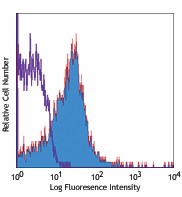
-

C57BL/6 mouse splenocytes stained with TR75-89 PE
| Cat # | Size | Price | Quantity Check Availability | Save | ||
|---|---|---|---|---|---|---|
| 113405 | 50 µg | 98€ | ||||
| 113406 | 200 µg | 276€ | ||||
CD120b is a 75 kD type I transmembrane protein, also known as Tumor Necrosis Factor Receptor Type II (TNFRII) or p75. It is expressed on a variety of cells at low levels; the expression is upregulated upon activation. This receptor binds both TNF-α and LT-α (also known as TNF-β). In association with TRAF1 and TRAF2, the receptor crosslinking induced by TNF-α or LT-α trimers is critical for signal transduction, leading to apoptosis, NF-kB activation, increased expression of proinflammatory genes, tumor necrosis, and cell differentiation depending on cell type and differentiation state.
Product DetailsProduct Details
- Verified Reactivity
- Mouse
- Antibody Type
- Monoclonal
- Host Species
- Armenian Hamster
- Immunogen
- E. coli -expressed mouse Type II TNFR
- Formulation
- Phosphate-buffered solution, pH 7.2, containing 0.09% sodium azide.
- Preparation
- The antibody was purified by affinity chromatography, and conjugated with PE under optimal conditions.
- Concentration
- 0.2 mg/ml
- Storage & Handling
- The antibody solution should be stored undiluted between 2°C and 8°C, and protected from prolonged exposure to light. Do not freeze.
- Application
-
FC - Quality tested
- Recommended Usage
-
Each lot of this antibody is quality control tested by immunofluorescent staining with flow cytometric analysis. For flow cytometric staining, the suggested use of this reagent is ≤1.0 µg per million cells in 100 µl volume. It is recommended that the reagent be titrated for optimal performance for each application.
- Excitation Laser
-
Blue Laser (488 nm)
Green Laser (532 nm)/Yellow-Green Laser (561 nm)
- Application Notes
-
Additional reported applications (for the relevant formats) include: immunoprecipitation1. The TR75-89 antibody does not block TNF-α binding to receptor. For most successful immunofluorescent staining results, it may be important to maximize signal over background by using a relatively bright fluorochrome-antibody conjugate (Cat. No. 113406) or by using a high sensitivity, three-layer staining technique (e.g., including a biotinylated antibody (Cat. No. 113404) or biotinylated anti-Armenian hamster IgG second step (Cat. No. 405501), followed by SAv-PE (Cat. No. 405204)).
-
Application References
(PubMed link indicates BioLegend citation) -
- Sheehan KC, et al. 1995. J. Exp. Med. 181:607. (IP)
- Schlaepfer DD, et al. 2007. J. Biol. Chem. 282:17450. (FC)
- Bell JH, et al. 2007. J. Leukoc. Biol. 82:173. (FC)
- Product Citations
-
- RRID
-
AB_2206941 (BioLegend Cat. No. 113405)
AB_2206941 (BioLegend Cat. No. 113406)
Antigen Details
- Structure
- TNFR superfamily, 75 kD
- Distribution
-
Variety of cell types at low levels
- Function
- Apoptosis, NF-κB activation, inflammation, tumor necrosis, cell differentiation
- Ligand/Receptor
- TNF-α, LT-α (TNF-β)
- Cell Type
- Tregs
- Biology Area
- Immunology, Innate Immunity
- Molecular Family
- CD Molecules, Cytokine/Chemokine Receptors
- Antigen References
-
1. Aggarwal BB, et al. 1985. Nature 318 665.
2. Chan FKM, et al. 2000. Science 288:2351.
3. Loetscher H, et al. 1990. Cell 61:351.
4. Rothe J, et al. 1993. Nature 364:798. - Gene ID
- 21938 View all products for this Gene ID
- UniProt
- View information about CD120b on UniProt.org
Related FAQs
- What type of PE do you use in your conjugates?
- We use R-PE in our conjugates.
Other Formats
View All CD120b Reagents Request Custom Conjugation| Description | Clone | Applications |
|---|---|---|
| Biotin anti-mouse CD120b (TNF R Type II/p75) | TR75-89 | FC |
| PE anti-mouse CD120b (TNF R Type II/p75) | TR75-89 | FC |
| TotalSeq™-A0893 anti-mouse CD120b (TNF R Type II/p75) | TR75-89 | PG |
| TotalSeq™-C0893 anti-mouse CD120b (TNF R Type II/p75) | TR75-89 | PG |
| Brilliant Violet 421™ anti-mouse CD120b (TNF R Type II/p75) | TR75-89 | FC |
Customers Also Purchased
Compare Data Across All Formats
This data display is provided for general comparisons between formats.
Your actual data may vary due to variations in samples, target cells, instruments and their settings, staining conditions, and other factors.
If you need assistance with selecting the best format contact our expert technical support team.
-
Biotin anti-mouse CD120b (TNF R Type II/p75)
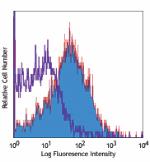
C57BL/6 mouse splenocytes stained with biotinylated TR75-89,... -
PE anti-mouse CD120b (TNF R Type II/p75)

C57BL/6 mouse splenocytes stained with TR75-89 PE -
TotalSeq™-A0893 anti-mouse CD120b (TNF R Type II/p75)
-
TotalSeq™-C0893 anti-mouse CD120b (TNF R Type II/p75)
-
Brilliant Violet 421™ anti-mouse CD120b (TNF R Type II/p75)

Con-A and IL-2 stimulated C57BL/6 splenocytes (2 days) were ...
 Login / Register
Login / Register 










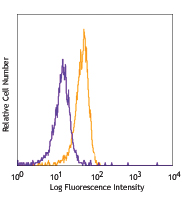
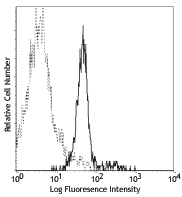
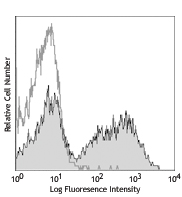
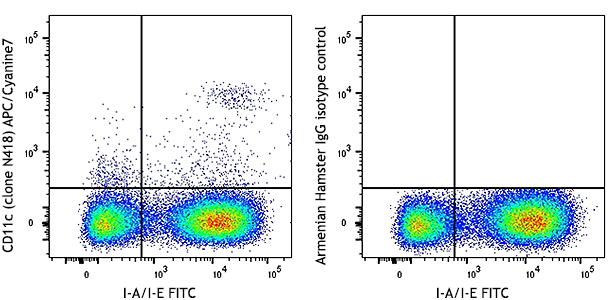



Follow Us